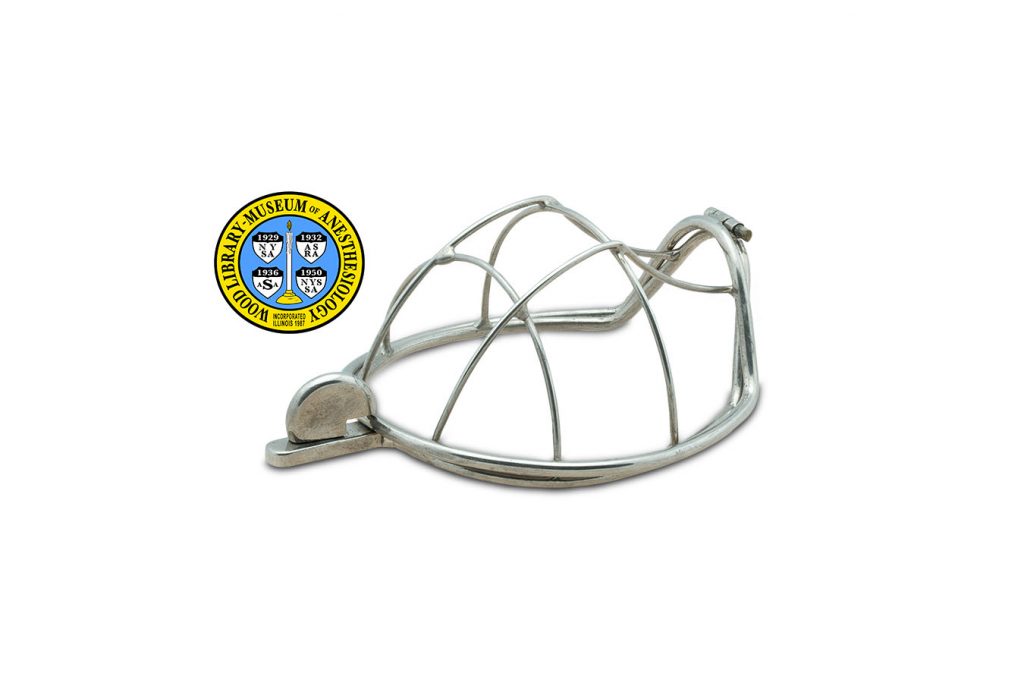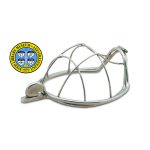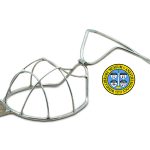Impey Mask
In open-drop anesthesia, the patient's nose and mouth were covered by a wire frame that was wrapped in cloth and soaked with a liquid anesthetic. British physician William Hotten George described his open-drop mask in 1906. This design truncates the top edge of the mask so that it ends below the bridge of the nose, an advantage for surgeries on the eye and sinuses. Intended for use with chloroform or chloroform mixtures, the cloth was held in place by a ring and fastened with a clasp. Mr. Hotten George was a member of the Royal College of Surgeons and the British Gynecological Society, and served as Senior Anaesthetist at both the Royal Orthopaedic Hospital and the Central London Throat, Nose and Ear Hospital. The original mask was made for him by Mayer & Meltzer. The example shown here was made by the London instrument firm, Arnold & Sons. This design was also offered by several other companies in the 1920s and 1930s. In their catalogs it was called the Impey mask. We do not know whether the Hotten George mask was associated with someone named Impey, or whether someone named Impey designed a similar mask.
Catalog Record: Impey Mask Impey Mask
Access Key: aqks
Accession No.: 2003-12-11-4 A
Title: Impey mask / Arnold & Sons.
Corporate Author: Arnold & Sons.
Title variation: Alt Title
Title: Hotten George mask.
Publisher: London : Arnold & Sons, [between 1900 and 1940?].
Physical Description: 1 anesthesia mask : metals ; 11 x 8.5 x 20 cm.
Subject: Masks, Anesthesia – wire frame.
Subject: Anesthesia, Inhalation – instrumentation.
Subject: Chloroform – administration & dosage.
Subject: Ether, Sulphuric.
Note Type: General
Notes: The date range is based on the earliest and latest published references found by the cataloger.
Described from the patient’s perspective, with the hinge at the front and the clasp at the back.
The date range is based on the earliest and latest published references found by the cataloger.
Described from the patient’s perspective, with the hinge at the front and the clasp at the back.
Note Type: Citation
Notes: Down Brothers. A Catalogue of Surgical Instruments and Appliances with Appendix, Including a Large Number of Original Designs Manufactured and Sold by Down Bros., Ltd. London: Down Brothers, Ltd., 1929:1336a.
Note Type: Citation
Notes: Elliott Brothers. Illustrated Catalogue, Surgical Instruments and Appliances, Aseptic Hospital Furniture, Electric Appliances, Diathermy Apparatus, etc., and Hospital Supplies, 5th ed. Sydney: Elliott Brothers Limited, 1929:5.
Note Type: Citation
Notes: Hotten George W. Chloroform mask. British Medical Journal. June 23, 1906;1:1469.
Note Type: Citation
Notes: Mayer & Phelps. An Illustrated Catalogue of Surgical Instruments and Appliances Manufactured and Sold by Mayer & Phelps. London: Mayer & Phelps, 1931:490.
Note Type: Citation
Notes: John Weiss & Son. Section II. Catalogue of Instruments for General Surgery. London: John Weiss & Son, Ltd., 1925:333.
Note Type: Citation
Notes: Wingrave W. Adenoids. London: Bailliere, Tindall and Cox, 1904:110-121. https://books.google.com/books?id=M2gPAAAAYAAJ&printsec=frontcover&dq=intitle:adenoid++inauthor:wingrave&hl=en&sa=X&ved=0ahUKEwi139LT4dTUAhVG6IMKHd1fDLIQ6AEIKjAB#v=onepage&q&f=false. Accessed June 23, 2017.
Note Type: Citation
Notes: Wooley, James, Sons and Co., Ltd. Catalogue of Surgeons’ Instruments and Appliances. Manchester, England: James Wooley, Sons & Co., Ltd., 1931:136.
Note Type: Physical Description
Notes: One anesthesia mask; Consists of a wire cage with four arching struts, a retaining ring, and a clasp; Both the cage of the mask and its retaining ring are roughly circular, except for a high peak at the front which accommodates the patient’s nose; The cage and the ring are hinged together at the front, at the top of the peak; When closed, the retaining ring slightly overlaps the cage; A short, flat metal bar extends from the back, which holds a flat, semi-circular clasp that pivots to left and right; This clasp holds the retaining ring in place; The clasp is marked: “ARNOLD & SONS [new line] LONDON”.
The short physical description gives the depth with the mask completely opened and the retaining ring standing fully open; The depth of the closed mask is approximately 11 centimeters; The short physical description gives the height of the mask with retaining ring standing upright; The ring would require support in order to be displayed in that position; The height of the closed mask is approximately 4 centimeters.
Note Type: Reproduction
Notes: Photographed by Mr. Steve Donisch, June 20, 2017.
Note Type: Historical
Notes: In open-drop anesthesia, the patient’s nose and mouth were covered by a wire frame that was wrapped in cloth and soaked with liquid anesthetic. In 1906, the British physician William Hotten George described “a modified mask that I have had made for the administration of chloroform or the C. E. mixture by the drop-bottle method”. The inventor stated that the mask “is so contrived as to leave the eyes of the patient always uncovered…. an advantage that speaks for itself …. in eye operations or those for the relief of frontal sinusitis the advantage is even more strongly marked.” Mr. Hotten George was a Member of the Royal College of Surgeons, a member of the British Gynecological Society, and served as Senior Anaesthetist at both the Royal Orthopaedic Hospital and the Central London Throat, Nose and Ear Hospital. The cataloger found him listed as Senior Anaesthetist at the latter hospital in issues of the Lancet dating from 1899 through 1910. He wrote the chapter on anesthesia in Wingrave’s 1904 textbook on adenoids. In that publication he described an ethyl chloride inhaler of his own design, which was also made by Mayer & Meltzer (pages 115-116.)
The original manufacturer was the London instrument maker, Mayer & Meltzer. In 1919, that company was succeeded by Mayer & Phelps. The latter company’s 1931 catalog includes the mask, but does not name it. The catalog quotes the 1906 description, but without attribution, and with one alteration in the text (changing the maker’s name from “Mayer & Meltzer” to “Mayer & Phelps”.)
The cataloger found this design in the catalogs of four other instrument makers, dated 1929 and 1931. Each of these state that it was designed for use in operations on the eye, and each of these names it the “Impey mask”. The cataloger found listings for several physicians surnamed Impey in the late 19th and early 20th Centuries, but none with any connection to anesthesia or eye surgery. This leaves open the questions of whether Hotten George’s mask was introduced by, or associated with, some person or institution named Impey, or whether someone named Impey designed a similar mask. The cataloged object was made by the London instrument manufacturer, Arnold & Sons. Founded in 1819, the company is known to have done business as Arnold & Sons from 1866 through the 1930s.
Note Type: Exhibition
Notes: Selected for the WLM website.



